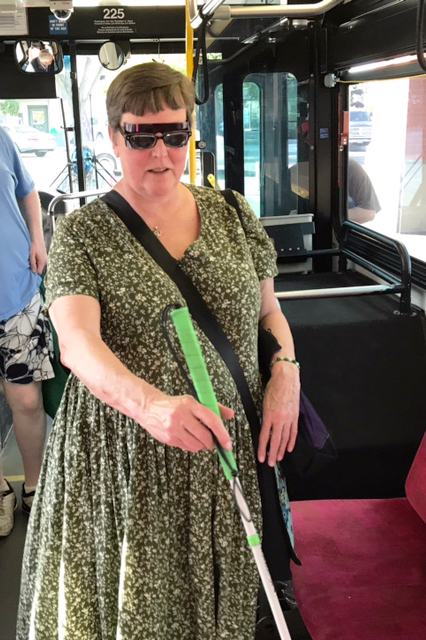For Marja Byers, a bus line is a lifeline.
Because of a genetic disorder, called Marfan syndrome, Byers has had eye problems since childhood. The chalkboard at school and the giant “E” at the top of her ophthalmologist’s eye chart appeared as a dark blur.
Her limited eyesight worsened with age. Seven years ago, the northeast Salem resident started using a white cane. Whether it’s a trip to the grocery store or getting to her job, Byers relies exclusively on public transit.
Byers serves as executive director of Blindskills Inc., a Salem-based nonprofit group. The dependence of the blind community on Cherriots has also made her a strong advocate for bus service.
Why she rides the bus
Most of Byers’ friends have vision impairments and she knows few drivers. If someone with a car offers her a ride to the store, she is more than likely to turn them down.
“I want to be able to get there on my own time, on my own terms,” said Byers, who has only a narrow field of clear vision and is legally blind.
Her remaining eyesight was once threatened by a medical emergency. It was a Cherriots Regional bus and a transfer to the Portland area’s TriMet transit system that got her to the Casey Eye Institute in time for surgery.
Cherriots has trained its employees to recognize the challenges facing people who are visually impaired. The training, Byers said, helps passengers travel with confidence. Small details, such as transit operators noticing blind passengers when they board the bus and being aware of their destinations, make a big difference, she said.
Byers also appreciates transit hosts, such as Daniel Kiener, who help Cherriots riders navigate the Downtown Transit Center: “We all love Daniel because he knows our patterns and watches out for us.”
Advice
Byers recommends the Cherriots free Travel Training program for those unsure of their ability to use transit. This instructional program is open to everyone.
“You really don’t have an excuse. You have someone who can do one-on-one training,” Byers said. Smartphone apps for navigation, some designed specifically for users who are blind, have also been a great help for those who are visually impaired, , she said.
Social isolation can be a hazard for persons with little or no vision, but all the skills required to use public transit can be learned, Byers said. She is encouraged by the numbers of bus riders, who are blind and visually impaired, she meets on Cherriots.
“I see a lot more white canes in downtown Salem than I ever saw before,” Byers said. “It’s good. We’re being mobile and staying engaged in the community.”
--Michael Rose
Do you have a great story about riding Cherriots or have a suggestion for a rider profile? Contact us at info@cherriots.org.


